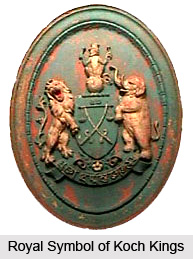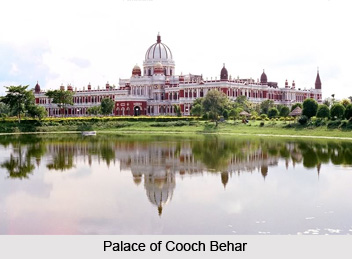 History of Cooch behar district dates back to the time of the Pala-Senas. Sculptures, coins of the Sultanate and the Mughal periods, temples, mosques of the mediaeval and late mediaeval period have been discovered herein. It has been seen from archaeological evidence that the territory of Kamrup played a role in the development of the present region of Cooch Behar district in West Bengal. The Kamrup territory has been mentioned as far back as the 4th century in the Allahabad Prasasti (Inscription) of the famous Gupta ruler, Samudra Gupta. During the 15th century AD, the western part of Kamrup came under the sway of the `Khen` dynasty to usher a new kingdom there known as `Kamta`. The present district of Cooch Behar owes its origin to this Kamta land. The founder of the dynasty was King Niladhvaja. It is stated by some that the Koch dynasty followed the lineage of his grandson Nilambar. Though this remains a disputed view, the more widely accepted view is that it was King Maharajah Viswa Singha who was responsible for the establishment of an independent Koch Kingdom in about 1510 AD or 1530 AD. This kingdom did not have a stable balance in the beginning. It acquired stability only when the capital was shifted to Cooch Behar. The Mughal forces grabbed certain portion of the `Kamta` kingdom in the middle of the 17th century AD. Later on the accounts of Badshanama, Shah-Jaha-nama, Tarikh-I-Assam and the Alamgirnama ascribed this territory as Cooch Behar.
History of Cooch behar district dates back to the time of the Pala-Senas. Sculptures, coins of the Sultanate and the Mughal periods, temples, mosques of the mediaeval and late mediaeval period have been discovered herein. It has been seen from archaeological evidence that the territory of Kamrup played a role in the development of the present region of Cooch Behar district in West Bengal. The Kamrup territory has been mentioned as far back as the 4th century in the Allahabad Prasasti (Inscription) of the famous Gupta ruler, Samudra Gupta. During the 15th century AD, the western part of Kamrup came under the sway of the `Khen` dynasty to usher a new kingdom there known as `Kamta`. The present district of Cooch Behar owes its origin to this Kamta land. The founder of the dynasty was King Niladhvaja. It is stated by some that the Koch dynasty followed the lineage of his grandson Nilambar. Though this remains a disputed view, the more widely accepted view is that it was King Maharajah Viswa Singha who was responsible for the establishment of an independent Koch Kingdom in about 1510 AD or 1530 AD. This kingdom did not have a stable balance in the beginning. It acquired stability only when the capital was shifted to Cooch Behar. The Mughal forces grabbed certain portion of the `Kamta` kingdom in the middle of the 17th century AD. Later on the accounts of Badshanama, Shah-Jaha-nama, Tarikh-I-Assam and the Alamgirnama ascribed this territory as Cooch Behar.
 The huge mound of Rajpat was discovered by archaeologists at the Gossanimari village. This marks the site of the ancient capital of Kamtapur of the Khen Kings. The pomp and glory of Rajpat are now all in ruins under the deposit of huge earth flanked by bare greeneries all around. It is believed that the ancient palatial complex of Kamtapur including the early Kamteswari temple are all lying buried in this mound. The mound is at present protected by the Archaeological Survey of India. The Cooch Behar Palace which is noted for its elegance and grandeur is also protected by the Archaeological Survey of India. Unfortunately, all the articles and the precious objects as contained by the various rooms and halls are now lost.
The huge mound of Rajpat was discovered by archaeologists at the Gossanimari village. This marks the site of the ancient capital of Kamtapur of the Khen Kings. The pomp and glory of Rajpat are now all in ruins under the deposit of huge earth flanked by bare greeneries all around. It is believed that the ancient palatial complex of Kamtapur including the early Kamteswari temple are all lying buried in this mound. The mound is at present protected by the Archaeological Survey of India. The Cooch Behar Palace which is noted for its elegance and grandeur is also protected by the Archaeological Survey of India. Unfortunately, all the articles and the precious objects as contained by the various rooms and halls are now lost.
In its later history, it may be stated that before 20th August 1949, Cooch Behar was a Princely State ruled by the Koch Kings of Cooch Behar, who had been a feudatory ruler under British Government. By an agreement dated 20th August, 1949 the king of Cooch Behar ceded full and extensive authority, jurisdiction and power of the state to the Dominion Government of India. The transfer of administration of the state to the Government of India came into force on 12th September, 1949. Eventually, Cooch Behar was transferred and merged with the province of West Bengal on 19th January, 1950 and from that date Cooch Behar emerged as a new District in the administrative map of West Bengal. However, the district of Cooch Behar had been created with the same area and boundaries as the old state of Cooch Behar. In course of time, Cooch Behar has been transformed from a kingdom to a state and from a state to the present status of a district.



















